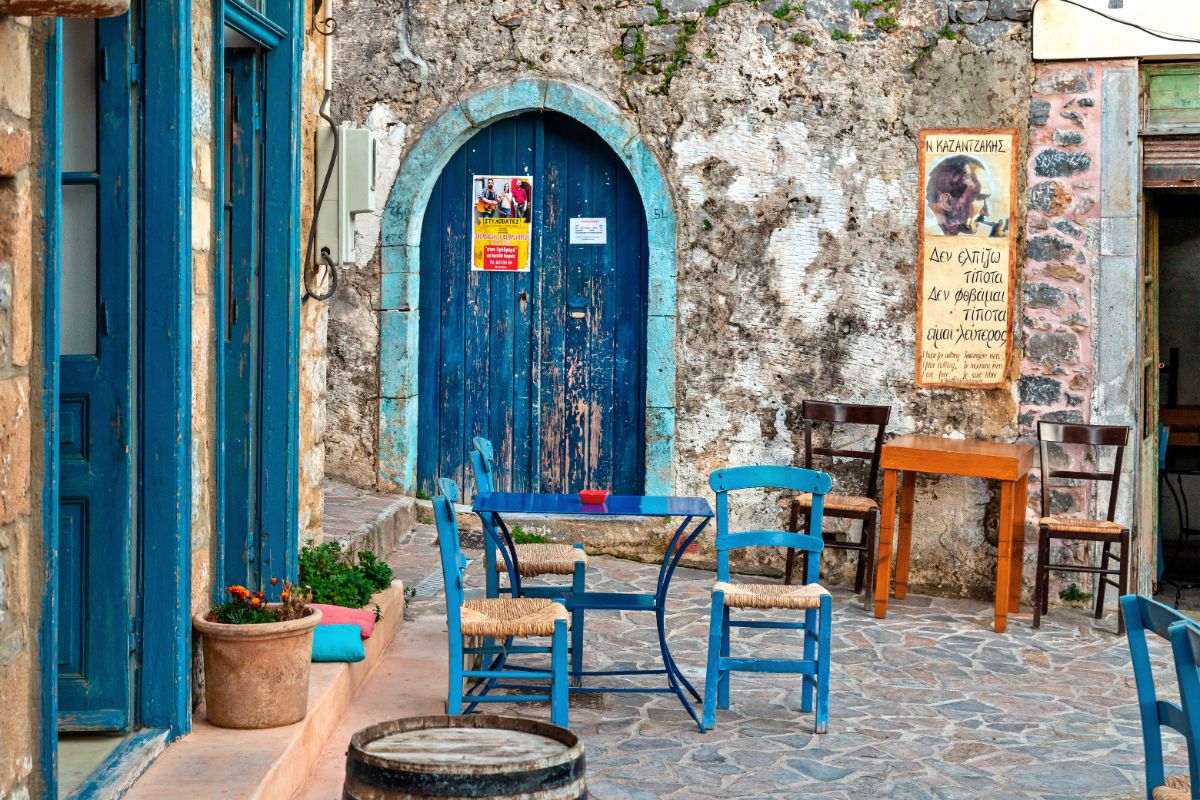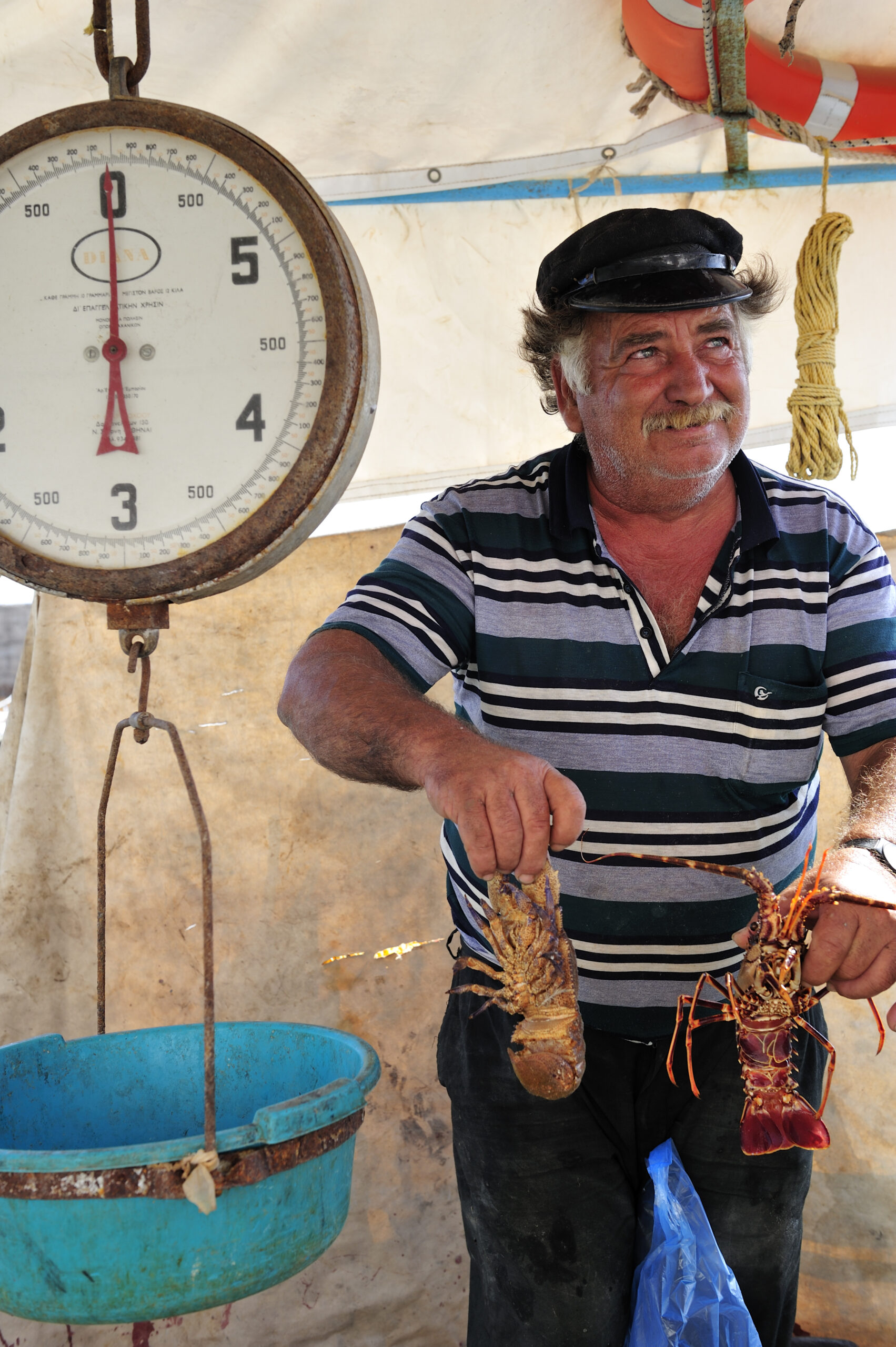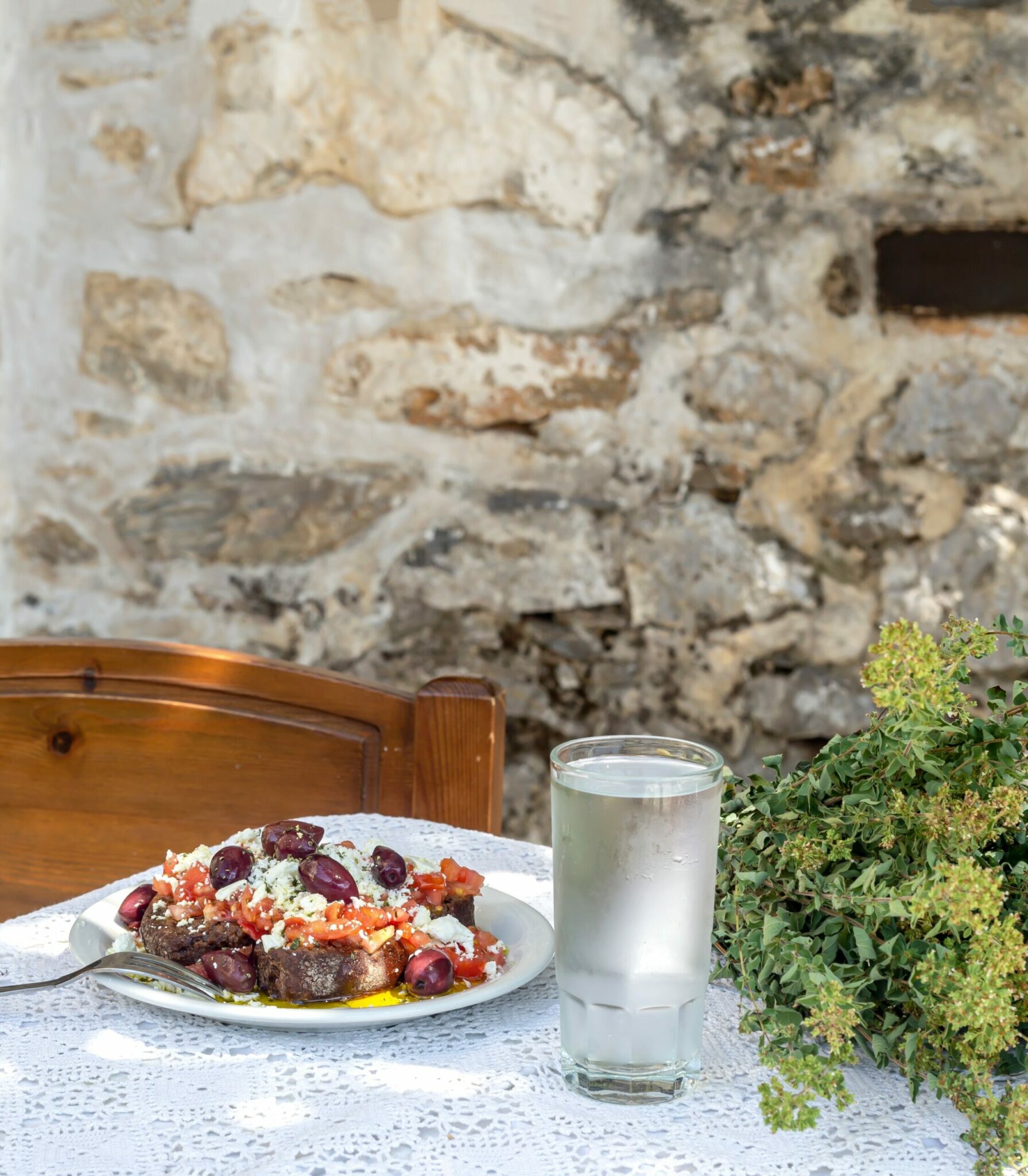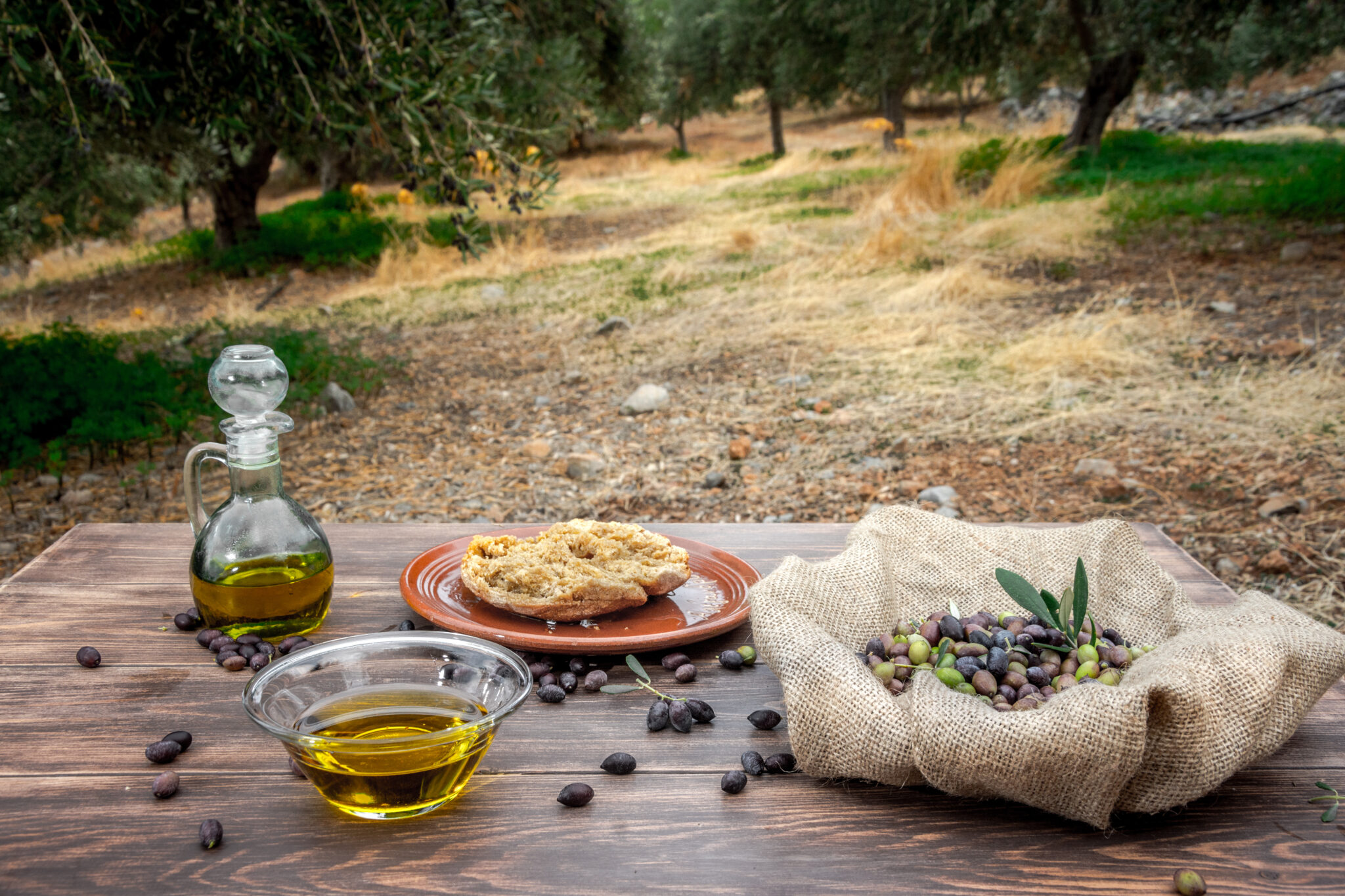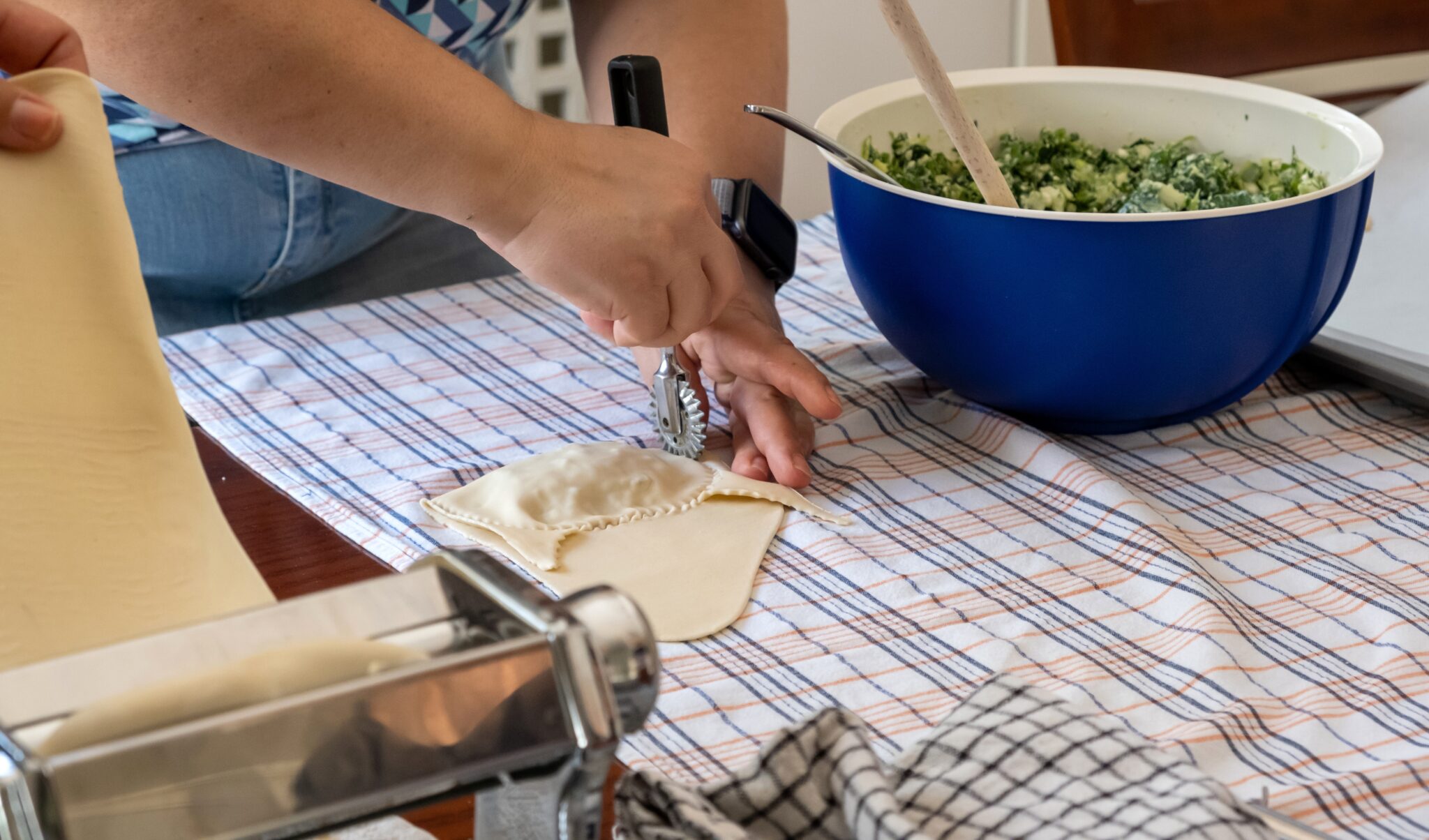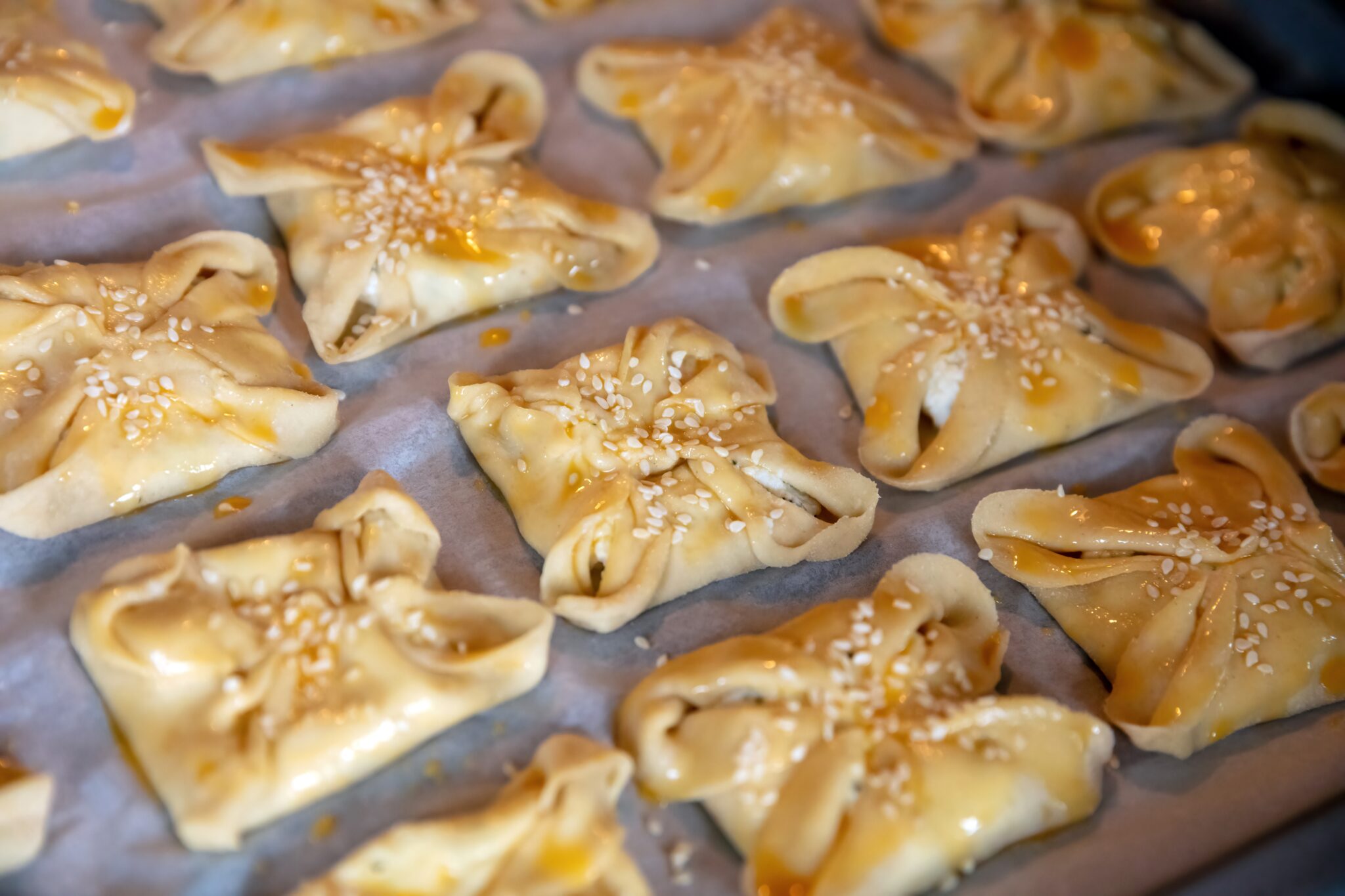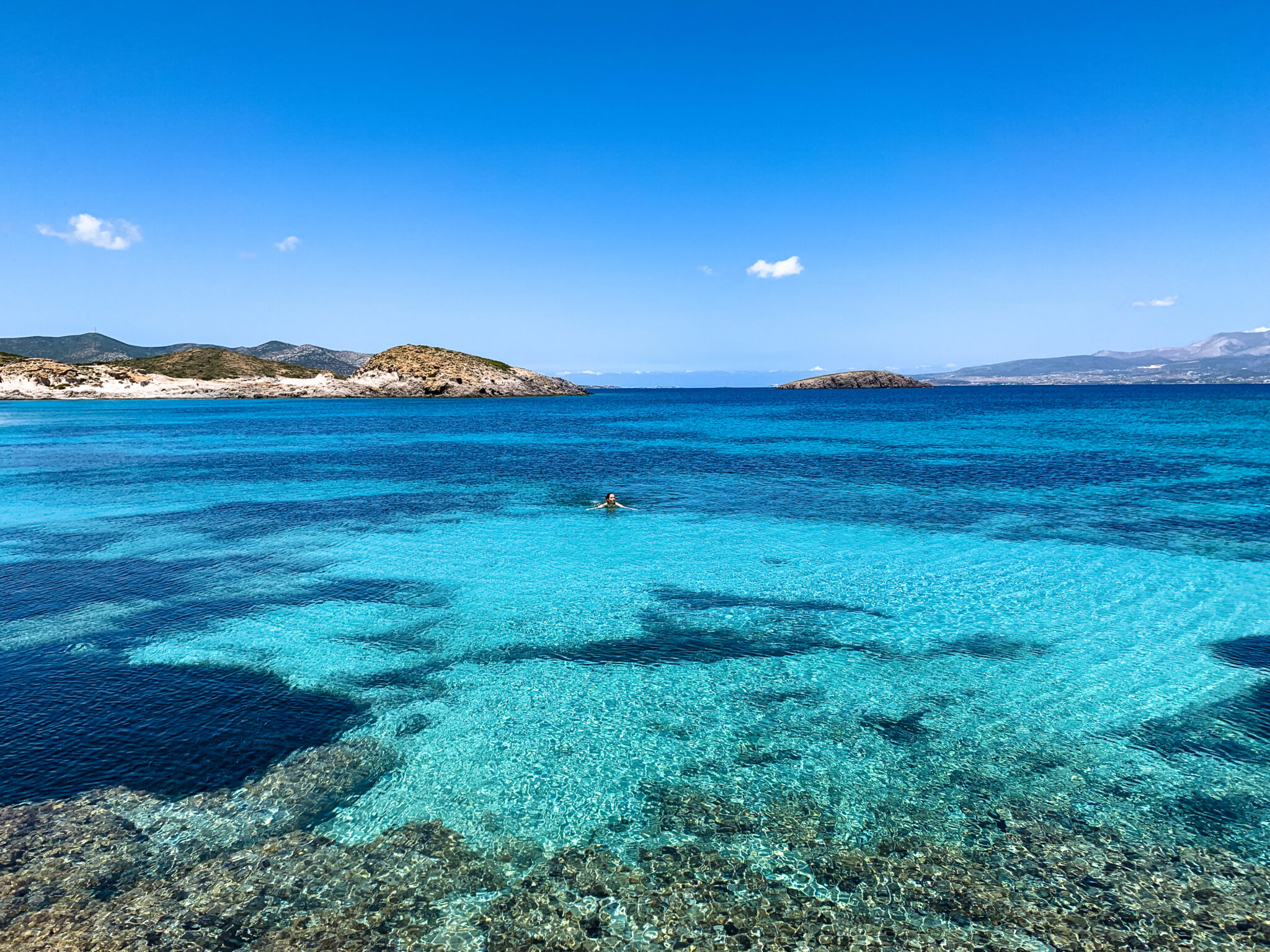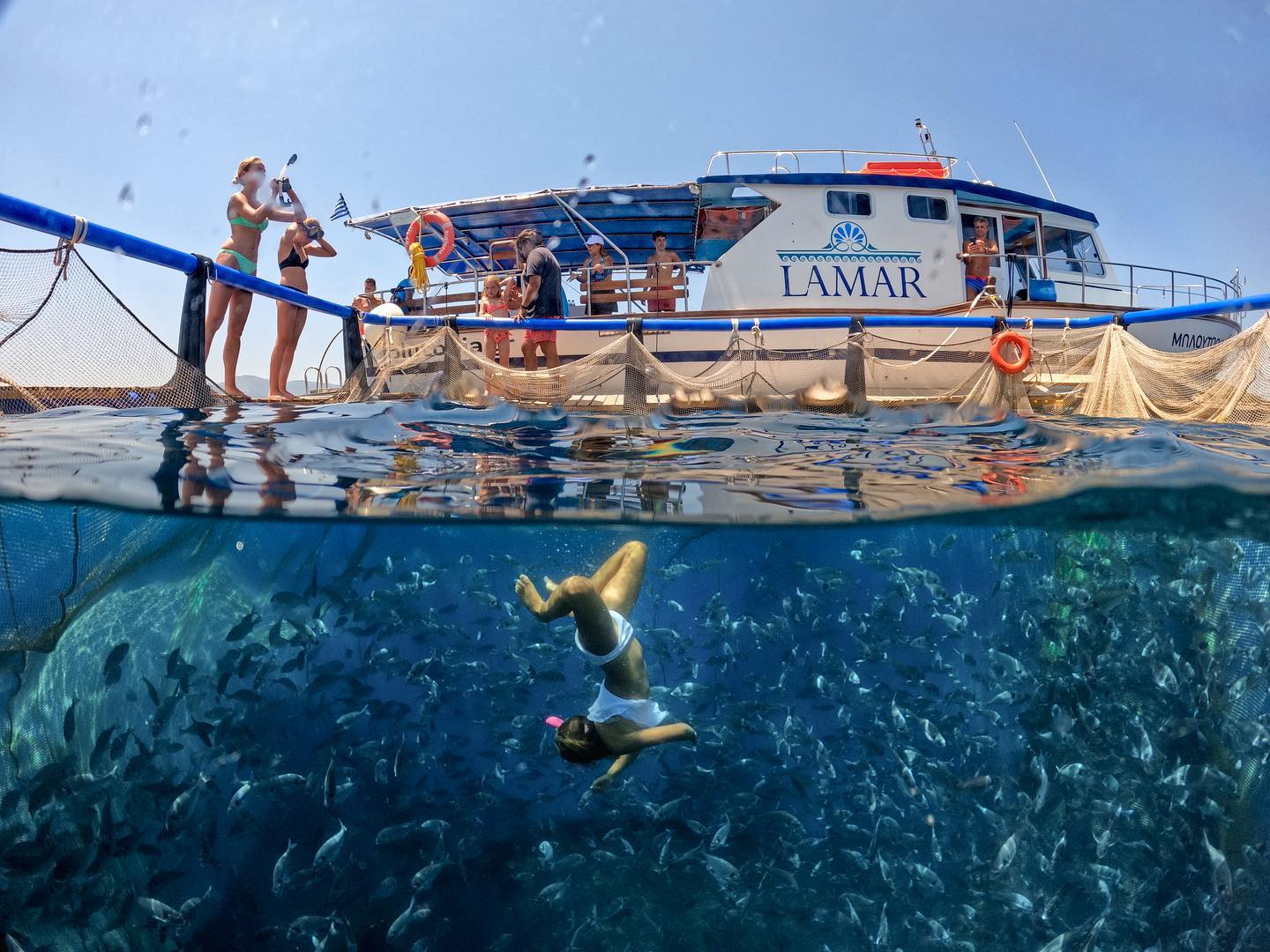Dividing Crete according to orientation, it’s fair to say that on its most eastern edge, the inhabitants consume the largest quantity of wild greens and mushrooms on the island, because there are still some “untrodden” areas.
Lassithi is divided into two; on one side are the plateaus and mountainous areas that remain cool even during the summer, and on the other side is the coastal area that stretches from Agios Nikolaos and Ierapetra to Sitia and the south. Up in the mountains, you can find fresh broad beans in August – a unique accompaniment for raki – and even tomatoes in December, along the coast. All these differences are reflected in Lassithi’s cuisine, which is defined primarily by its home-grown vegetables.
The quintessential summer dish is ‘sofegada’, which encapsulates the culinary philosophy of Lassithi and, by extension, Crete. It is a vegetarian dish, but in Crete, no one would ever think to label themselves vegetarian. They eat plenty of greens because they love them; it’s an ingrained part of their culinary culture. To make the dish, courgettes, onions and potatoes chopped into cubes, and beans (both ‘bambakia’ beans with small pods, also known as ‘symiana’, and rounder ‘asprokolia’ beans) are cooked in a large, shallow pot together with exceptional virgin olive oil. Okra, small peppers, garlic, tomatoes, ‘goula’ leaves, aubergines, ‘vlita’ (a type of green) and ‘stroufigga’ (a bitter herb) are also added – the latter in limited quantity due to its bitterness.
This is an emblematic summer dish, capturing the spirit of simplicity and, at the same time, made with an abundance of techniques and flavours.
On the plateau, roast pork with local potatoes has taken centre stage in the local cuisine, as well as soup with wild rooster or chicken, which is often served at feasts or weddings, culminating after hours of wine drinking. The locals of Sitia, known as both exceptional fishermen and fish connoisseurs, fish in Dionysades, as are the people of Gerapetra, with recipes like ‘kakavia’ (fish soup) of the Libyan Sea, their famous scorpion fish soup, fried red mullets, and grilled large fish. The housewives of Sitia are renowned for their pastries and other desserts, more so here than anywhere else on Crete.
Recipies from Lassithi
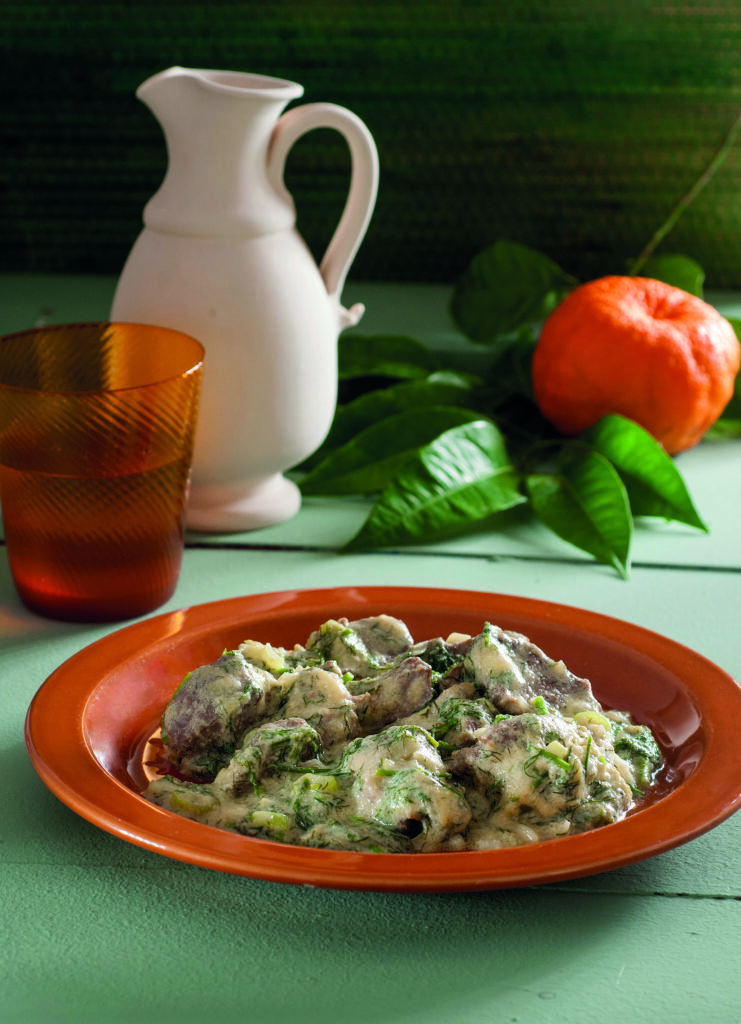
Lamb Fricassee with Fennel and Orange-Infused Yogurt
A modern take on a classic dish, lamb with fennel is complemented and enhanced by the aroma of orange.
Serves 4
Preparation Time: 20 minutes
Cooking Time: 1 hour + 30 minutes
Cost: €3.50 per serving
Ingredients
1 kg lamb meat (from the neck), cut into large cubes
½ cup extra virgin olive oil
1 bay leaf
1 whole clove
1 dry onion, finely chopped
1 clove garlic, finely chopped
1 tbsp flour
Zest and juice of 1 orange
2 orange leaves
1 cup dry white wine
1 kg fennel, coarsely chopped
2 eggs
Juice of ½ lemon
2 tbsp strained yogurt
5 fresh spring onions, white and green parts, sliced
Salt and pepper to taste
Procedure
In a large bowl, season the lamb meat with salt and pepper and vigorously mix to coat the meat evenly. In a wide, deep pot, heat the olive oil over high heat and sauté the lamb meat with the bay leaf and clove for 5-7 minutes, until browned on all sides. Add the onion and garlic and continue sautéing for 1-2 minutes. Sprinkle with flour, add half of the orange zest and the orange leaves, and deglaze with the wine. Allow 1-2 minutes for the alcohol to evaporate, then add enough water to reach a level one finger above the meat. Reduce the heat to medium, cover with a lid, and simmer for 30 minutes. Add the fennel and continue simmering for at least 50 more minutes, until the meat is tender and the sauce has thickened. Remove from heat and let the dish rest on the warm stove.
Egg-Lemon (‘Avgolemono’): In a small bowl, mix the yoghurt with 2-3 tbsp of juice from the dish. In two deep plates, separate the egg yolks from the whites, and whisk the whites with a wire whisk until they start to thicken. To the yolks, add the juice from the orange and lemon, and whisk thoroughly. Gradually incorporate a few tablespoons of the liquid from the pot while continuing to whisk. Once the yolks are well combined with the liquid, add the beaten egg whites and gently fold them in. Remove the dish from the heat and add the egg mixture, stirring in a circular motion to homogenize the ingredients without cutting them. Add the yogurt and fresh spring onions, stirring gently. Serve the dish hot, drizzling a few drops of oil on top.
Note: For a more sophisticated presentation, garnish with fresh fennel fronds or a sprinkle of fennel pollen.
Tips
Ask your butcher to clean the meat, removing the skin and leaving a thin layer of fat on top. This enhances the flavor and helps the sauce caramelize better. For an additional flavor dimension, add a few pieces of barley rusks to each plate. They provide a unique texture and absorb the sauce beautifully. Along with the fennel, you can add pitted green olives (without the pits) for a traditional Cretan combination (e.g., octopus with fennel and olives). They add an extra acidity and richness to the dish. Note: The Greek term “soupies” refers to small octopuses or cuttlefish in this context.
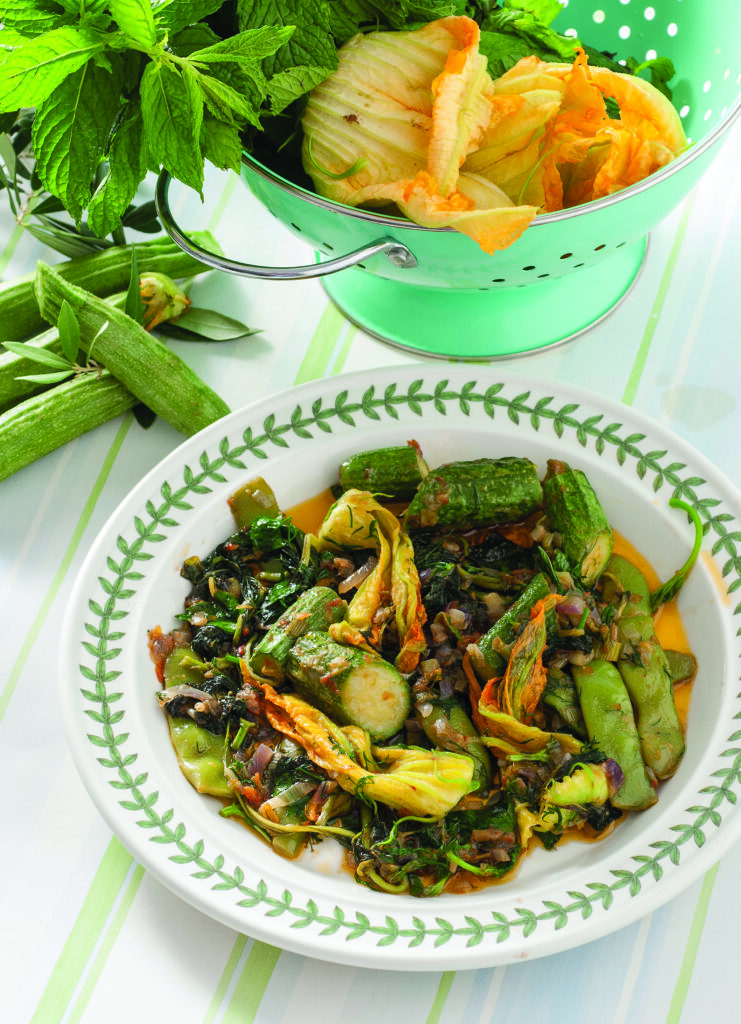
Cretan ‘Sofegada’
Known as ‘Sofegada’ on the eastern side, ‘Simbethero’ on the western side, and ‘Sofiko’ in the middle region—this is a delightful fusion of summer vegetables and herbs.
Serves 4
Preparation: 30 minutes
Cooking time: 30 minutes
Ingredients
80 ml extra virgin olive oil
1 large dried onion, finely diced
3 fresh spring onions, sliced
300 g green beans
1 handful fresh green peas
12 small courgettes and their blossoms
1 bunch fresh fennel, finely chopped
2 ripe tomatoes, grated
2-3 potatoes, roughly chopped
2 sprigs of lovage, whole leaves or finely chopped
1 sprig of fresh basil, whole leaves or finely chopped
2 sprigs of fresh mint, whole leaves or finely chopped
Zest and juice of 1 unwaxed lemon
Salt and pepper
Procedure
Gather some green beans, 2 blossoms from the tomato plant and 2 small courgettes with their blossoms, and a bunch of spring onions, 1 large dried onion and a few potatoes. For the herbs, chop a generous amount of fennel, and a few handfuls of basil leaves and mint leaves. You’ll also need the zest of 1 lemon.
Sautee all the vegetables in a pot with a generous glug of olive oil over medium heat, each in their turn (for 2-3 minutes). Season with salt and pepper.
Simmer for 5-10 minutes, and add the potatoes, fennel, basil, mint and lemon zest. Sautee for another 5-10 minutes, until softened and then add a little more salt to taste. Once they come to a boil, pour some raw olive oil into the ladle or, better yet, onto the plate along with chilli pepper and remove from the heat.
Tips
Sofegada is a traditional summer dish from Crete, for which locals use whatever fresh, seasonal ingredients they have available. The quantities and types of vegetables mentioned are indicative. Make the necessary additions or subtractions based on your preferences and supplies.
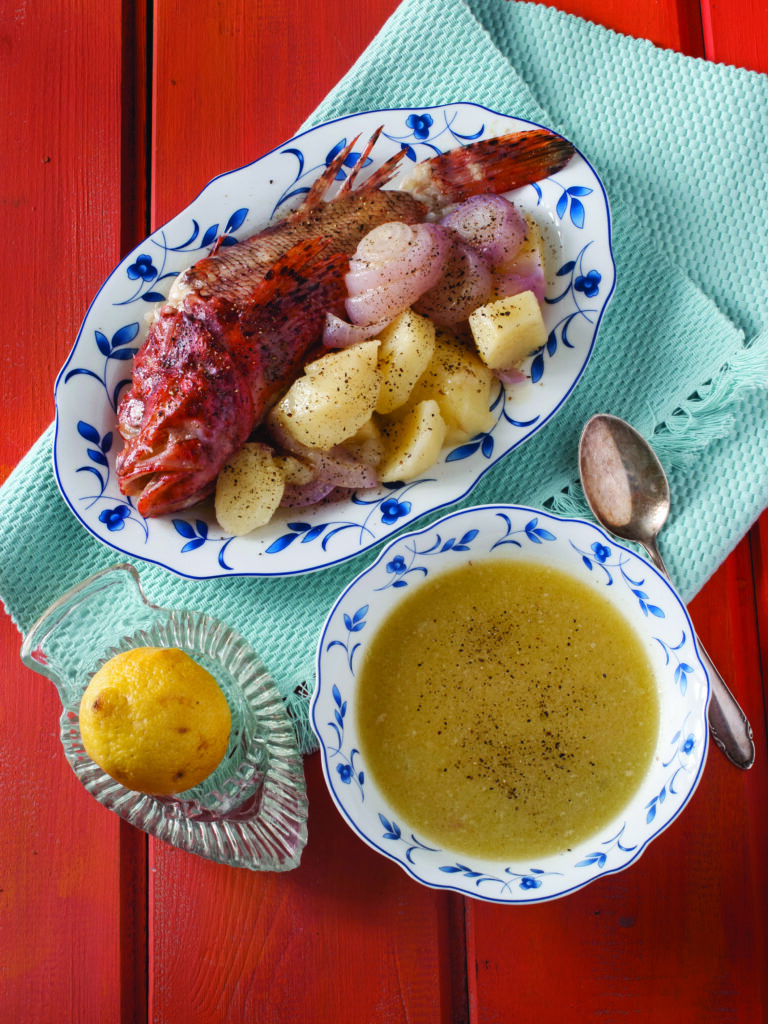
Libyan Kakavia Soup
Serves 6
Preparation: 20 minutes
Cooking time: 45 minutes
Ingredients
2 large onions, thickly sliced
1 kg potatoes, thickly sliced
1 kg large fish (grouper, snapper, sole), cleaned
1 kg small fish (scorpionfish, mullet, etc.), cleaned
1½ cups extra virgin olive oil
1½ cups lemon juice
Salt and freshly ground pepper
Procedure
Spread the onions on the bottom of an oiled pot. Layer the potatoes on top, followed by the large fish, ensuring there are no gaps between them. Next, add another layer of onions, then potatoes, and finally, the small fish to prevent them from disintegrating. Pour in enough water to cover the ingredients, drizzle with olive oil, season with salt, and bring to a boil over medium to high heat with the pot covered for 20 minutes. Uncover and continue simmering over medium to low heat for another 15 minutes. Just before the end, add the lemon juice. Carefully remove the small fish, large fish, potatoes, and onions layer by layer. Serve the broth with a generous amount of freshly ground pepper and arrange the fish and potatoes with onions on a platter to serve alongside it.
Tips
Kakavia becomes even more delicious with the addition of the fish heads. The fishermen’s recipe says to use as much oil as lemon juice, but feel free to adjust the quantity according to your taste. If desired, add 2-3 courgettes, thickly sliced, along with the potatoes. The vegetables and fish will have almost dissolved by the end, but all their deliciousness will have transferred to the broth. Clean the fish thoroughly and add them to the broth if you prefer it that way.
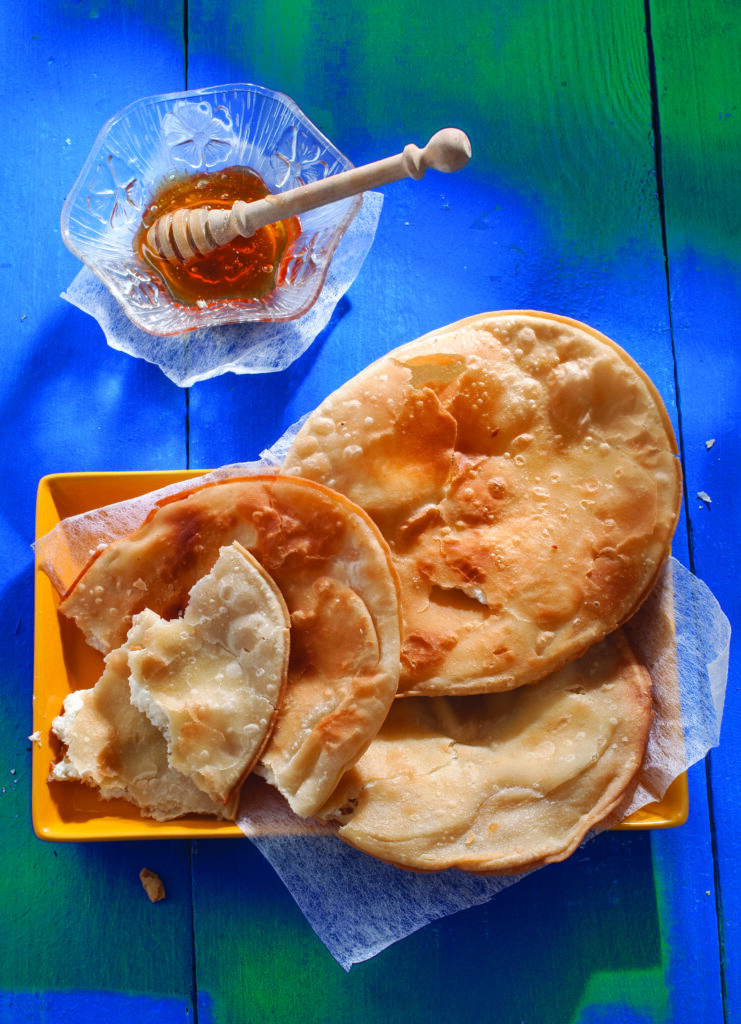
‘Watered’ Myzithropites
These pies are called ‘watered’ because one needs to constantly wet their hands with water when working with the dough.
Serves 4
Preparation time: 20 minutes
Frying time: 30 minutes
Resting time: 10-15 minutes
Ingredients
350 g sour myzithra cheese
250 ml water
1-2 tbsp extra virgin olive oil (optional)
250-300 g all-purpose flour
Salt and pepper
Procedure
In a bowl, crumble the sour myzithra cheese with your hands to soften it. Shape the mixture into small balls (about the size of walnuts) and place them on a plate or tray. Refrigerate for 10-15 minutes. In another bowl, combine water, olive oil (optional), a pinch of salt, a little pepper, and gradually add the flour. Mix with your hands until you form a thick, pourable batter-like dough. Heat a non-stick frying pan over medium heat and take the sour myzithra cheese out of the refrigerator. As soon as the pan is hot, wet your hands and take about 2 tbsp of the dough in your palm. Make a hollow in the dough and place a myzithra cheese ball inside. Seal the dough tightly around the cheese and place it in the centre of the pan. With wet fingers, press and flatten the dough from the centre towards the edges until the pita becomes thin enough (approximately 20-22 cm in diameter). Fry the water-soaked pies one by one for about 10-15 minutes on each side until the dough turns lightly golden. Serve the pies plain or with honey.
Tips
The exact amount of flour depends on its quality. Gradually add it to the mixture while stirring until you achieve the desired texture. When making these pies, it is helpful to have a bowl of water nearby to frequently wet your hands and work with the dough more effectively.
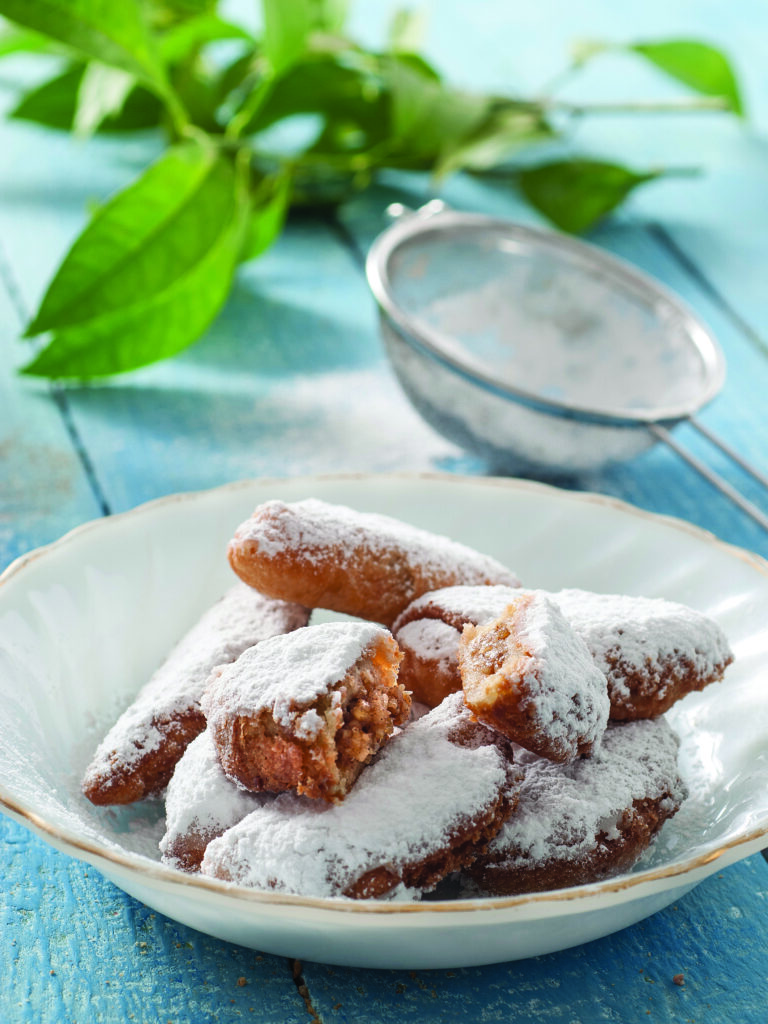
Patouda
A traditional Lassithian sweet drizzled in powdered sugar, filled with nuts and flavoured with spices. A festive dessert that housewives prepare at home, a sweet delight representing happiness and marriage, alongside xerotigana and almond cookies.
Makes about 30 pieces
Preparation time: 1 hour
Baking time: 20-25 minutes
Resting time: 40 minutes
Ingredients
For the dough
½ cup extra virgin olive oil
½ cup sunflower oil
1/3 cup granulated white sugar
½ cup orange juice
1 shot of lemon juice
½ shot of raki
1 tsp fine salt
1 tsp baking soda
4½-5 cups all-purpose flour
For the filling
1 cup blanched almonds, coarsely ground
1 cup walnuts, coarsely ground
½ cup sesame seeds
1 cup orange or lemon marmalade (or finely chopped spoon sweets)
½ cup honey
1 tsp cinnamon
1/3 tsp nutmeg
¼ tsp cloves
1/3 shot of rosewater
Rosewater and powdered sugar for serving
Procedure
Dough: In a deep bowl, combine the oils and sugar and mix well with your hands. Add the juices, raki, salt, and baking soda, and continue mixing. Gradually add the flour while constantly mixing with your hands until you have a relatively firm dough that does not stick to your hands. Cover with a cotton towel and let it rest for about 30 minutes.
Filling: Place all the filling ingredients in a large bowl and mix well with a large spoon until combined.
Assembly: Preheat the oven to 180°C (fan-assisted). Line two baking trays with parchment paper. Divide the dough into 10-12 pieces and on a floured work surface, roll out each piece into thin sheets about 0.5 cm thick. Each piece will yield 3-4 patouda. Cut out dough discs with a round cookie cutter, 6-8 cm in diameter. Place 1 tsp of the filling in the center of each disc and fold it in half, lightly pressing with your fingers to seal the edges and prevent them from opening during baking. Repeat the process with all the dough pieces. Place the patouda on the baking trays, leaving a distance of 3-4 cm between them to prevent sticking when they rise during baking.
Bake for 20-25 minutes until golden brown. Allow them to cool slightly for 5-10 minutes. Sprinkle with rosewater, dust generously with powdered sugar, and serve.
Note: In Kissamos, these sweets are called “skaltsounia.” The name “patouda” is used here to refer to them.
Tips
The exact quantity of flour needed for the recipe depends on its quality. Add it gradually while mixing until you achieve the desired texture. You can also shape the patouda into round or slightly elongated shapes. Store patouda in a tightly sealed container or metal box for several days in a dry and cool place.
Lassithi Raw Materials
Among the most agriculturally prosperous areas in the whole country, Lassithi is home to products of exceptional quality and unique taste. It is responsible for 1.5% of our total agricultural output, ranking 6th as an olive oil producer, 6th in potato production, and 7th in tomato production within Greece.
It’s no coincidence then that many of the products from Eastern Crete are among the most well-known outside of the island, with some even exported internationally.
The exceptional virgin P.D.O. olive oil ‘Sitia Lassithiou Crete’ appears in many overseas markets. Meanwhile, the exceptional virgin olive oil from the village of Kritsa in Sitia has garnered international awards and recognition. A variety of fruits and vegetables are grown in the region, especially in Ierapetra, which has been dubbed the ‘vegetable garden of Europe’, as large quantities are exported abroad. On the Lassithi Plateau, legumes—some rare like ‘manarolia’ and ‘asprokoulia’—and delicious potatoes are grown, while quality dairy products can be found throughout the prefecture.
The vineyards, covering somewhere around 6.6 acres, are primarily found in the easternmost part of the Sitia province, which is almost entirely covered by the same-named Protected Designation of Origin. The Liatiko grape, likely originating from there, forms the backbone of the dry red P.D.O Sitia., supplemented with up to 20% Mandilariá, while the Vilana similarly constitutes the white, supplemented with up to 30% of the Thrapsathiri variety. For the red sweet wines, only ‘Liatiko’ can be used, while for the ‘Malvasia Sitia’ designation, the legislation is the same as that of Handakas.
Among dairy products, Xygalo Sitias PDO stands out. This is a white, slightly acidic, gelatinous, creamy cheese made from sheep and goat’s milk, brimming with refreshing and earthy flavours. It pairs beautifully with Cretan rusk, or ‘dakos’, and with summertime vegetable stew, or ‘sofegada’, encompassing all sorts of garden vegetables.
Lassithi boasts numerous fishing spots and skillful fishermen who deliver the tastiest fish and seafood to homes and restaurants, always cooked following local recipes of simplicity and deliciousness. Sitia is renowned for its extremely delectable traditional sweets, like ‘xerotigana’ (fried dough strips), ‘anevata kalitsounia’ (‘raised’ sweet cheese pies), almond pear-shaped sweets, ‘kalitsounia lychnarakia’ (small lantern-shaped pastries), ‘loukoumia anevata’ (‘raised’ Turkish delight, akin to doughnuts), and the excellent quality honey it produces.
Potatoes and legumes star in many of Lassithi’s recipes, either cooked on their own or accompanied by vegetables, meat or fish. Many pies are made in a frying pan, filled with xygalo, thus combining the heat of the fried dough with the sour freshness of the cheese. A local speciality is oven-baked pork with local potatoes cut in half, lemon juice and a bit of thyme, without other spices.




